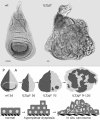Drosophila lethal giant larvae neoplastic mutant as a genetic tool for cancer modeling
- PMID: 19440511
- PMCID: PMC2679652
- DOI: 10.2174/138920208784340786
Drosophila lethal giant larvae neoplastic mutant as a genetic tool for cancer modeling
Abstract
Drosophila lethal giant larvae (lgl) is a tumour suppressor gene whose function in establishing apical-basal cell polarity as well as in exerting proliferation control in epithelial tissues is conserved between flies and mammals. Individuals bearing lgl null mutations show a gradual loss of tissue architecture and an extended larval life in which cell proliferation never ceases and no differentiation occurs, resulting in prepupal lethality. When tissues from those individuals are transplanted into adult normal recipients, a subset of cells, possibly the cancer stem units, are again able to proliferate and give rise to metastases which migrate to distant sites killing the host. This phenotype closely resembles that of mammalian epithelial cancers, in which loss of cell polarity is one of the hallmarks of a malignant, metastatic behaviour associated with poor prognosis. Lgl protein shares with its human counterpart Human giant larvae-1 (Hugl-1) significant stretches of sequence similarity that we demonstrated to translate into a complete functional conservation, pointing out a role in cell proliferation control and tumorigenesis also for the human homologue. The functional conservation and the power of fly genetics, that allows the researcher to manipulate the fly genome at a level of precision that exceeds that of any other multicellular genetic system, make this Drosophila mutant a very suitable model in which to investigate the mechanisms underlying epithelial tumour formation, progression and metastatisation. In this review, we will summarise the results obtained in these later years using this model for the study of cancer biology. Moreover, we will discuss how recent advances in developmental genetics techniques have succeeded in enhancing the similarities between fly and human tumorigenesis, giving Drosophila a pivotal role in the study of such a complex genetic disease.
Keywords: Drosophila; Hugl-1; Lethal giant larvae; animal model.; epithelial cancers; tumour suppressor.
Figures





Similar articles
-
The human protein Hugl-1 substitutes for Drosophila lethal giant larvae tumour suppressor function in vivo.Oncogene. 2004 Nov 11;23(53):8688-94. doi: 10.1038/sj.onc.1208023. Oncogene. 2004. PMID: 15467749
-
Reduced expression of Hugl-1, the human homologue of Drosophila tumour suppressor gene lgl, contributes to progression of colorectal cancer.Oncogene. 2005 Apr 28;24(19):3100-9. doi: 10.1038/sj.onc.1208520. Oncogene. 2005. PMID: 15735678
-
Connecting epithelial polarity, proliferation and cancer in Drosophila: the many faces of lgl loss of function.Int J Dev Biol. 2013;57(9-10):677-87. doi: 10.1387/ijdb.130285dg. Int J Dev Biol. 2013. PMID: 24395559 Review.
-
The lethal giant larvae tumour suppressor mutation requires dMyc oncoprotein to promote clonal malignancy.BMC Biol. 2010 Apr 7;8:33. doi: 10.1186/1741-7007-8-33. BMC Biol. 2010. PMID: 20374622 Free PMC article.
-
Lethal (2) giant larvae: an indispensable regulator of cell polarity and cancer development.Int J Biol Sci. 2015 Feb 15;11(4):380-9. doi: 10.7150/ijbs.11243. eCollection 2015. Int J Biol Sci. 2015. PMID: 25798058 Free PMC article. Review.
Cited by
-
Toll-7 promotes tumour growth and invasion in Drosophila.Cell Prolif. 2022 Feb;55(2):e13188. doi: 10.1111/cpr.13188. Epub 2022 Jan 20. Cell Prolif. 2022. PMID: 35050535 Free PMC article.
-
Modeling tumor invasion and metastasis in Drosophila.Dis Model Mech. 2011 Nov;4(6):753-61. doi: 10.1242/dmm.006908. Epub 2011 Oct 6. Dis Model Mech. 2011. PMID: 21979943 Free PMC article. Review.
-
A conserved polybasic domain mediates plasma membrane targeting of Lgl and its regulation by hypoxia.J Cell Biol. 2015 Oct 26;211(2):273-86. doi: 10.1083/jcb.201503067. Epub 2015 Oct 19. J Cell Biol. 2015. PMID: 26483556 Free PMC article.
-
Comparative study of tumorigenesis and tumor immunity in invertebrates and nonmammalian vertebrates.Dev Comp Immunol. 2010 Sep;34(9):915-25. doi: 10.1016/j.dci.2010.05.011. Epub 2010 Jun 2. Dev Comp Immunol. 2010. PMID: 20553753 Free PMC article. Review.
-
Distribution of lethal giant larvae (Lgl) protein in the tegument and negative impact of siRNA-based gene silencing on worm surface structure and egg hatching in Schistosoma japonicum.Parasitol Res. 2014 Jan;113(1):1-9. doi: 10.1007/s00436-013-3620-z. Epub 2013 Oct 6. Parasitol Res. 2014. PMID: 24096609
References
-
- Hanahan D, Weiberg RA. The hallmarks of cancer. Cell. 2000;100:57–70. - PubMed
-
- Mareel M, Leroy A. Clinical, cellular and molecular aspects of cancer invasion. Physiol. Rev. 2003;83:337–376. - PubMed
-
- Bilder D. Epithelial polarity and proliferation control: links from the Drosophila neoplastic tumor suppressors. Genes Dev. 2004;18:1909–1925. - PubMed
-
- Humbert P, Russel S, Richardson H. Dgl, Scribble and Lgl in cell polarity, cell proliferation and cancer. Bioessays. 2003;25:542–53. - PubMed
LinkOut - more resources
Full Text Sources
Molecular Biology Databases
